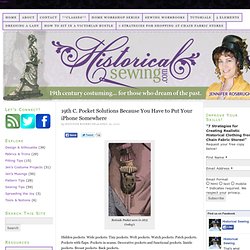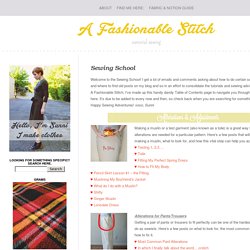

Hecklinger's ladies' garments. Clone Yourself A Fitting Assistant. David Coffin Duct-tape dress form (above) uses ordinary duct-tape as both the body-casting material and the final form.

Another version of this Duct-tape dress form (not shown) is a bit more difficult but produces a closer fit. Check out this updated method for creating the ultimate fitting assistant. Sloan Howard by David Coffin A few years ago I had a custom-fitted body form made for myself, which totally changed the way I fit clothes and alter patterns. What's so earthshaking about having a clone in the sewing room? Minor adjustments become so easy and obvious when you're looking at the actual problem in fabric on "yourself" that you often don't even need a muslin or a corrected pattern. Making a Shirred-Back Dress, Part One: Modifying Your Pattern.
As promised!

This technique isn't difficult, but it has a few parts, so I'm going to break it up into three posts. Part one is modifying a dress back pattern so it's the right size to be shirred with elastic thread. We're going to be talking about strappy and strapless patterns, so no full-coverage dress backs. (Note: there is a way to shirr a full coverage dress back, and that's to change the style lines so you have side panels underneath the arms, and then shirr those.) Note: the only special supply you'll need for the whole tutorial is elastic thread. You can modify a basic dress back bodice like so. Important: don't forget to add a seam allowance at the top of the new back pattern piece. 19th C. Pocket Solutions Because You Have to Put Your iPhone Somewhere. Reticule Pocket seen in 1875 Godey’s Hidden pockets.

Wide pockets. Tiny pockets. Welt pockets. Watch pockets. It truly is amazing the variety and locations of pockets in 19th Century clothing! For easy reference, let’s look at where our ancestors carried personal items in pockets sewn into their garments. Regency 1800-1820: 1800 Lady with Reticule Bag Before the Regency era, personal items were held in pocket bags that were tied underneath the petticoats (skirts) and accessed through slits in the sides.
Corset Making Supplies : Corset Supplies, Corset Patterns, Corset Boning and more at great prices! Fitting techniques (various) 10 Better Sewing Habits. Your sewing habits can often make or break a project.

Good habits enhance your results, while bad habits-which may at first seem rewarding-stymie success. In this article from Threads #164 (December '12/January '13), we asked our authors to share what they considered to be good habits for a better sewing experience. It's easy to believe that developing good habits requires herculean efforts. But to replace one behavior with another, you simply need to be aware of how you sew, rather than sewing on auto-pilot. Take small steps; change one behavior for each new project.
Sewers sometimes drag a garment through the needle and feed dogs in an attempt to get a smooth, pucker-free seam or to move delicate fabric through the machine without snagging. To eliminate puckers the correct way, adjust your machine's tension setting, and use the correct needle and the correct size thread. 1 | 2 | 3 | 4 | 5 | 6 | 7 | 8 | 9 | 10next> View all. Sewing School. Welcome to the Sewing School!

I get a lot of emails and comments asking about how to do certain sewing related things and where to find old posts on my blog and so in an effort to consolidate the tutorials and sewing advice you find here on A Fashionable Stitch, I’ve made up this handy dandy Table of Contents page to navigate you through what’s available here. It’s due to be added to every now and then, so check back when you are searching for something and can’t find it. Happy Sewing Adventures! Xoxo, Sunni Making a muslin or a test garment (also known as a toile) is a great way to find out if certain alterations are needed for a particular pattern. Alterations for Pants/Trousers Getting a pair of pants or trousers to fit perfectly can be one of the hardest fittings we ever do as sewists. Flat Pattern Adjustments Flat Pattern Adjustments are adjustments made to the pattern before you make a muslin. Off The Cuff ~Sewing Style~
Sewing forums and blogs. Coats. Style. See How A Couture Gown Is Made Entirely By Hand - BuzzFeed Mobile. County Public Library Catalog /All Locations.